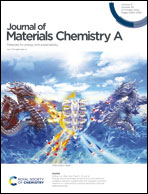Aliovalent doping engineering enables multiple modulations of FeS2 anodes to achieve fast and durable sodium storage†
Abstract
Metal sulfide anodes have trigged extensive academic progress in high-performance sodium-ion batteries (SIBs). However, their poor electronic conductivity and slack diffusion kinetics severely hinder their practical application. Herein, an efficient strategy to overcome the above-mentioned issues via heteroatom doping is proposed. As a demonstration, phosphorus-doped FeS2 nano-spindles encapsulated by a carbon layer (P–FeS2@C) are produced and investigated as an anode material for SIBs. As expected, the as-designed P–FeS2@C electrode presents a remarkably high specific capacity (624.4 mA h g−1 at 1.0 A g−1 after 100 cycles), admirable rate performance (401.2 mA h g−1 at 10.0 A g−1), and impressive cycling stability (285.4 mA h g−1 at 20.0 A g−1 over 4000 cycles). Furthermore, reaction kinetic analysis shows that the P–FeS2@C anode presents a high capacitive contribution ratio and large diffusion coefficient of Na+ during the sodium storage process compared with the undoped FeS2@C. Simultaneously, density functional theory validates that P doping ameliorates the electronic structure of FeS2 and induces the formation of a local built-in electric field around the doping sites, reducing the diffusion energy carriers of Na+ and accelerating the charge transport.



 Please wait while we load your content...
Please wait while we load your content...